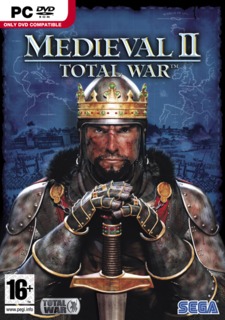Medieval II: Total War is easily the best real-time strategy game in recent times.
User Rating: 9.2 | Medieval II: Total War PC
NOTE: Because this review is so long, Gamespot has automatically removed all indentations, thus making a wall of text. I apologize. After rave reviews, I decided to buy Company of Heroes, the World War II real-time strategy game from the renowned RTS developer, Relic. Not long after, I bought Medieval II: Total War, enchanted by the epic battle scenes. Among the two games, Medieval II has shown itself to be the pinnacle of excellence: it provides more than enough content to keep the game enjoyable for hour upon hour. In Company of Heroes, one plays as one of two warring armies, and battle it out for an hour on a single map in which they generate hundreds of men out of small buildings and dozens of tanks out of thin air. They then blast the feces out of eachother. In Medieval II, a standard ten-minute "battle" involves two or more armies of opposing alliances or mixed association lining up in a parade formation and, also, removing feces in a violent fashion. Multiple units of from twenty to a few hundred infantry, archers, cavalry, and artillery gather in an easily modified deployment - thus adding up to as much as tens of thousands of soldiers (on godly systems, of course). In a standard "battle", five hundred to two thousand men will engage eachother; the player can dictate down to the unit the methods of destruction, thus allowing a grand amount of tactical variation; not to mention the hundreds of varying types of units that can be used. And that's just in the field "battle" phase. In Company of Heroes, one can enjoy a skirmish battle on one of ten maps or a short, linear campaign on variable difficulties. In Medieval II, one can enjoy a quick battle with random armies and random units; a custom battle with chosen armies and units on a chosen map (of which twenty or so are available); or the Grand Campaign mode, which truly lives up to its title. There is also a small multiplayer component, of which we will return to later. In the campaign mode, one chooses a nation; dozens are available, each with varying playing styles befitting the initial location and military make-up. The grand campaign spans all of western and central Europe - including the Iberian Peninsula, Italy, and Denmark, along with North Africa, most of Eastern Europe, some of Russia, and western Middle East. In turn-based style, the player will lead their nation to global victory in either the short campaign or the long campaign. In the short campaign, the player is charged with destroying one or two opposing nations and capturing a small amount of territory (usually fifteen regions), and normally lasts six-to-ten hours. The long campaign involves capturing one or two specific regions (such as Jerusalem or Rome), and a large amount of territory (usually forty-five regions), and normally lasts fifteen-to-thirty hours. During the Grand Campaign, the player moves armies of differing make up across the medieval lands, entering the previously described battle phase when they engage enemy armies or towns. Towns and castles are the basis of territory in the campaign; towns provide money while castles provide advanced troops. To capture territory, one must siege a town, thus entering a battle phase in which the player maneuvers siege weapons (rams, towers, ladder, trebuchets, catapults and eventually cannons of all sorts) to bring down the walls of the besieged settlement. Troops must the enter the breach, thus commencing a battle that also gives room for all kinds of tactical improvisation. Joining armies in the grand campaign are merchants, diplomats, assassins, spies, and princesses, all of which have some strategic value. Merchants are somewhat useless; they can be positioned over a resource and they will generate a small amount of "florins" (the global currency, in this case) until they die of age or are bankrupted by an opposing merchant. Diplomats are necessary; they, unsurprisingly, negotiate with other nations, to appeal ceasefires, alliances, or all manner of territory-bartering and bribing. Assassins assassinate; they can be useful, but are not all that necessary. Spies spy; these are as useless as merchants, as anyone can see into an enemy army or town given proximity. Princesses can be used as diplomats, or marry another nation's prince to cement an alliance. All campaign units, including generals, evolve in an RPG-like fashion. A general who sieges often will gain a siege instructor, and have a bonus to command while a sieging. A priest that executes heretics may be joined by a witchhunter, and will become more pious. A prince that kills prisoners and burns towns will be awarded dread, and may soon have an executor following in his wake. A general you use on the forefront will soon become a great commander given many victories; a governor you leave at the capital will soon wallow in laziness, becoming corrupt and disillusioned.
In the battle phase, you can zoom in and out and examine at the soldier's level. The game looks very nice at this level, and runs smoothly on older computers. At the campaign phase, the icons are what you would expect from a turn-based view, but textures could have been more realistic. Sound, from the horn of cavalry charging into a spear wall, or the whistle of flaming arrows flying past your screen, are all very good; sadly, you must be zoomed in a good bit to hear the chaos of battle. In some aspects, the user interface is somewhat clunky, but this has been exaggerated a good bit; everything works very well. Overall, Medieval II: Total War is an excellent real-time and turn-based strategy game, with plenty of replay value, and deserves merit in all aspects. 
